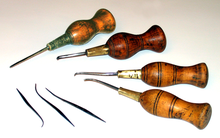Stitching awl
This article needs additional citations for verification. (August 2014) |

A stitching awl is a tool with which holes can be punctured in a variety of materials, or existing holes can be enlarged. It is also used for sewing heavy materials, such as leather or canvas. It is a thin, tapered metal shaft, coming to a sharp point, either straight or slightly bent. These shafts are often in the form of interchangeable needles. They usually have an eye piercing at the pointed end to aid in drawing
History
A small copper awl from a Tel Tsaf grave in Israel is currently the oldest metal object discovered in the Middle East.[1]

Awls were used by the Eastern and Middle Dakota (Sioux) and by the peoples of the Red River region, including the Red River Métis, Anishinabe, Plains Cree, and Salteaux.[2]
In terms of nomenclature,
When he was a child,
See also
References
- ^ "This Tiny Copper Awl Is Rewriting History". Newser. 25 August 2014. Retrieved 25 August 2014.
- ^ "Awl Case". Brooklyn Museum. Retrieved 22 July 2014.
- ISSN 0025-7273.
